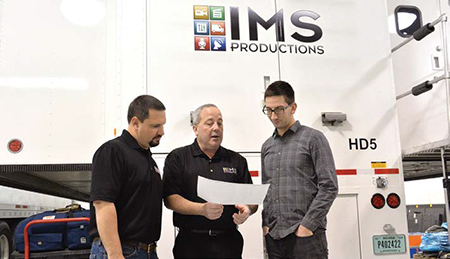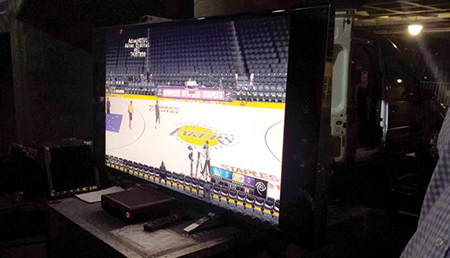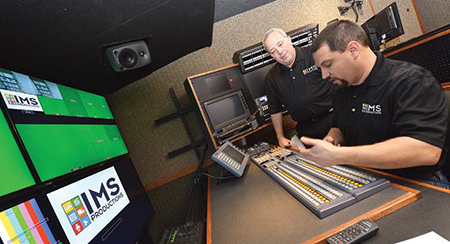TWC Sports Conducts UHDTV Tests

IMS Productions Supervising Engineer Paul Nijak, IMSP President Robby Greene and Evertz Field Support Engineer Steven Jazvac review plans to integrate Evertz equipment into IMSP’s HD5 production truck for the first 4K video concept tests.
LOS ANGELES— Time Warner Cable Sports recently completed the successful production of two “proof-of-concept” 4K broadcasts to test the format’s viability, from the venue to a set-top box in the home. Both broadcasts—the California Interscholastic Federation high school football Division 1 Championship Game on Dec. 19, and an NBA regular season game between the Los Angeles Lakers and the Golden State Warriors at the Staples Center in Los Angeles on Dec. 23—were available only on closed circuit TVs on TWC SportsNet.
“To my knowledge, this is the first time this has ever been done, soup to nuts, with every camera being 4K,” said Robby Greene, president of IMS Productions, the Indianapolis-based mobile production company that provided trucks and systems integration. “It was a well-organized plan with good partners. A lot of people worked very hard to get it ready and that paid off.”
FIRST USE IN BROADCAST ENVIRONMENT
Vendors including Sony, Canon, Adtec Digital, ChyronHego, Evertz and Cisco partnered with TWC Sports for the broadcasts, many using their 4K gear in a real broadcast environment for the first time. Four Sony PMW-F55 cameras were set up at both venues, equipped with Canon lenses: the Cine-Servo 17-120mm T2.95 zoom lenses and ultra-telephoto Cine-Servo 50-1000mm T5.0-8.9 Ultra-Telephoto Zoom lens. According to Ryan Kamata, Canon’s senior specialist in the company’s DS/Video/Lens Business Planning division, the just-released 50-1000mm lens is aimed at 4K and greater image capture.
Dan Perry, national accounts production manager for Sony Professional Solutions of America, reported that each F55 camera was set up with the company’s 4K live system, which consists of a CA-4000 camera system adaptor attached to the camera’s docking interface, and a BPU-4000 baseband processor unit, combined with an existing HDCU-2000/HDCU-2500 camera control unit connected by optical fiber cable.
“The 4K live system is what’s allowed us to turn a cinema camera into a studio camera,” Perry explained. “Now [the camera signal] comes back to the truck, and the video operator is able to control the camera the way he would any studio camera.”
Sony also provided its PWS-4000 server and MVS-8000 switcher (the latter of which was used for last year’s World Cup 4K broadcast), which were installed in the IMS Production truck. Perry said that the server also recorded a MXF file to a separate hard drive, which became a 4K archival record of the event as soon as the game was over.
Get the TV Tech Newsletter
The professional video industry's #1 source for news, trends and product and tech information. Sign up below.
IMS monitored the 4K signal prior to the start of the Dec. 23 game between the Lakers and Warriors. SIGNAL PATH AND GRAPHICS
Four Adtec EN-100 multi-codec encoders took the four 3GSDI signals from the cameras and multiplexed them into a single multi-program transport stream signal, which was sent over Time Warner’s fiber network to its El Segundo, Calif. studio. In addition to transport over the fiber network, the signal was also carried via IntelSat’s G19 satellite. “This is very common in sports, to take two paths,” said Coastal Media Group President Bob Adler, whose company provided the SNG truck. “It’s live, so if you lose one signal, you’ve got the other. We took the data signal and handed it off to our normal transmission chain.”

At the El Segundo studio, four Adtec TD-70 1080p decoders decoded the signal. Jay Gedanken, sales engineer for Nashville, Tenn.-based Adtec, noted that synchronizing was a challenge. “To get good clean signals, it has to be a good SDI signal coming out of the truck,” he said. Adtec had its first 4K experience providing encoding for the file-based 4K transmission of “War Horse” in London last March (“4K ‘War Horse’ Transmitted Live From London Stage,”). But Gedanken notes that his team learned something new by participating in the TWC Sports broadcasts. “There is no 4K test pattern,” he said. “We realized that when we were setting up for the first TWC Sports broadcast.” The answer was to create their own, using a moving crosshatch to show timing errors.
ChyronHego’s 4K Mosaic was used to create game graphics and Evertz—in addition to signal routing with its EQX router— provided four DreamCatchers in the El Segundo studio. “Each DreamCatcher takes in one camera stream,” explained Gaylen Clutter, feld applications engineer for Burlington, Ontario-based Evertz, who added that the teams had been prepping for two days to make sure all the kinks were worked out. “We’re doing replays as they happen and building highlights packages.” Clutter said there were no glitches. “We took a 4K camera signal and put it right out,” she says. “It’s gone very smoothly.”
At the El Segundo studio, Cisco’s AnyRes Live encoder compressed/encoded the signal into HEVC, and then sent it—via National Video Transport network—to Time Warner Cable’s lab/headend in Peaksville, Colo. The Colorado-based headend then sent it back to the El Segundo studio, testing the robustness of signal transport.

IMS Productions Supervising Engineer Paul Nijak and IMSP President Robby Greene with the Sony switcher that will be used for the 4K tests. “We’re taking the contribution signal that’s being fed to the studio and transcoding it across the Time Warner network,” said Ken Dumont, director of market management for Cisco. “We have 12 GB of video coming into our encoder and we compress it to 19 megs, using our algorithms.” The Cisco AnyRes Live encoder is a 1RU box based on its UCS hardware and can process a 4K 60p 10-bit signal, as was done at the Staples Center. The signal was finally decoded by a Cisco consumer set-top box to a 4KTV, viewed by a select group of Time Warner executives.
The work it took to pull off the event wasn’t trivial. “We’ve been talking about this for five or six months and working on it for a couple of months,” said Greene. “We had to reintegrate and refit the truck to be ready for it. With Ultra HD, there’s a lot more data, so it’s a little bit of the unknown. But we did the math, we did the homework and we had a lot of very smart people involved.”
Live sporting events are likely to be a “killer app” for Ultra HD, so TWC Sports’ proof-of-concept tests were a logical step in moving towards that eventuality. “Time Warner is being very smart to figure out the practicalities and problem areas now,” said Adtec’s Gedanken. “We know we’re going to be in the 4K broadcast space at some point, whether it’s six months a year or two years. And we’ll be well prepared for this.”
